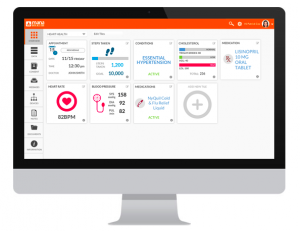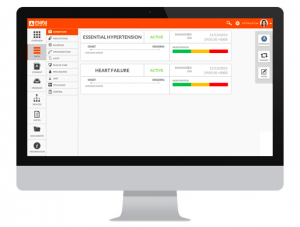In addition to developing apps that allow patients to track their lifestyle habits—exercise, diet, sleep patterns, etc—mHealth is also promising in its potential to engage patients in their general health information. Specifically, in the information that is stored in hospital health records. A play on EHRs, Mana Health has developed “a patient portal solution that has been designed for today’s consumer.”
Mana Health is a New York startup that won the opportunity to design the patient portal for the New York eHealth Collaborative, a non-profit organization that works to improve health care for New Yorkers through the development and establishment of electronic health records. Mana Health recently designed an interface that facilitates the sharing of patient data around the state, not only between hospitals, but also from hospital-to-patient. The endeavor is unique because it is not contained in a single healthcare system, but rather will pull information from across the state and consolidate it in a user-friendly “patient portal” platform.
One of the best features of the program, at least in my opinion, is how user-friendly the interface appears to be. While existing electronic medical records (such as Epic) are filled with numbers and abbreviations, Mana Health’s platform is truly geared towards the patient and offers streamlined graphics that illustrate the patient’s relevant health information.
Mana Health’s platform transforms the complex electronic health record into a personal health record that allows patients easy access to their information: “unlike the clunky PHRs of days past, they said they wanted something that a typical consumer would feel comfortable using.” Their concern for user-centered designs is something that all mHealth developers should strive to emulate. The liberal use of color-coded graphics is a simple way to increase the scope of users, especially to those who may have low health literacy and will serve to benefit from the image-based layout.
As mHealth advances, there are many issues that will continue to spring up. I have addressed several of these in past blog posts—addressing low health literacy, accessing hard-to-reach populations, funding mHealth endeavors—and the creation of user-friendly platforms is yet another point of serious consideration. mHealth is a direct product of creativity and innovation, and these driving forces should not stop at the development of the idea, but carry over into the details of its execution.
http://www.mhealthnews.com/news/new-patient-portals-bring-mobility-hix?page=0
http://mana-health.com
http://nyehealth.org/about-nyec/



The goal was usability in the real world. The design is based on clinical experience and a lot of design features were a nod to something people could easily relate to. You hit it on the head in terms of the colors and the graphics. Red, yellow, green was to remind people of a traffic light. The app-like visuals were to remind people of a Windows desktop and their smartphone screens. Most importantly, the universality of certain symbols like the heart, were to address literacy and health literacy issues. I have taught patients about their health issues and even conducted formal classes on topics like diabetes and hypertension in the past and insights gathered from these experiences definitely played a role in the approach and the design. Language was also important. Simplicity for understanding, and being a native NY-er, the recognition of the city as a diverse melting pot. The Spanish classes I took in college served me well in working in community health centers where sometimes 50% of patients spoke a non-English first language.
Additionally, it was also designed to help patients have the most important information and this would help them when seeing clinicians. So things like a baseline blood pressure or heart rate are included because it’s important to know what is normal for a particular patient, along with normal ranges.
Mobile is incredibly important. In terms of access, a lot of people have smartphones but may not have landlines or desktops. Additionally, mobile is the dominant way in which people access information. Any subway ride in NYC will show 7/10 people on their phone.
This project was about creating something useful and making the health experience more pleasant. Kind of like a mint.com or Turbo Tax for healthcare. Design was incredibly important. Why not make something that was practical, useful AND aesthetically pleasing? It was about making peoples lives easier so they would not have to hunt for records. Additionally, I put in the emergency access feature so that at 3 am if someone comes into the ER unconscious & we didn’t know their history or meds, a doctor could access the records from the hospital and the unique situation would be flagged in the system as a special access scenario.
Thanks for the write-up. You definitely touched upon a lot of the thoughts and considerations that went into this.
Thank you very much for your response–I really appreciate that you took the time to expand on your project.
I am currently working on a separate mHealth project for the Houston community, and your concern for usability among a diverse population as well as the advantages of mobility are two features that we have also been focusing on in our health campaign, and that really caught my eye while reading about Mana Health.
Somehow I managed to miss the emergency access feature in my initial review; it is a great idea that makes so much sense, but could have been easily looked over. As a student and junior researcher, I am still learning about the development of mHealth technologies and really enjoyed learning about your product and all of the considerations that went into producing something “practical, useful AND aesthetically pleasing,” as you said.
I’m looking forward to hearing more about Mana Health (and hopefully other programs like it) in the future.
Thanks again for reading!